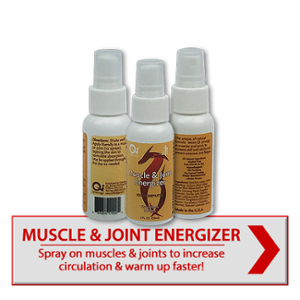The colder weather and changing seasons has many athletes dreaming of winter sports like hockey, skiing and ice skating. Whether you are an athlete who participates in winter sports or just someone who continues their training regimens outside in the winter, knowing how to prepare your body and mind for training in the cold weather is crucial to performing at your highest ability and minimizing the risk of injury.
We’ve previously discussed how to workout in warm weather but now that the air is getting cooler, let’s take a look at how to best prepare for cold weather training.
1. Layer & gear up
When training in the cold, it’s incredibly important that you dress appropriately. You want to be warm without sweating so much that you get a chill. An easy rule of thumb you can follow is to try and dress as if it’s 20 degrees warmer outside than it actually is and dress in easy-to-remove layers in case you do start sweating and need to remove something. Also make sure that all extremities are covered as they radiate a large amount of heat. Check out this great blog post for some guidelines to start with.
Don’t forget to make sure your feet are properly equipped as well, especially if it’s wet outside. To keep the warmth in and slush out, choose shoes that have the least amount of mesh possible and wear socks that wick away wetness but keep your feet warm.
EXPERT TIP: The best type of shoes to workout in are those with Gore-Tex uppers. So if you live in a place in which you’re continually training in the wet (we’re talking to you Pacific Northwest!), investing in Gore-Tex upper shoes might just be worth their weight in gold.
 2. Warm up
2. Warm up
As with any training session, it’s important to warm up. But in the case of training outside, you want to try and warm up your body as much as possible before even stepping out the door. Take some time to do some dynamic stretching (link to this blog when live) before you head outside. Then move your warmup outside so your body can start adjusting to the change before you launch into the most intense portion of your workout.
In addition, when working out in the cold, you want to invest more time in your warm-up than you would in the summer. The body takes longer to warm up in the winter and a cold start can result in injury due to shock in the muscles, tendons, ligaments and joints.
3. Stay hydrated
Training in cold weather might cause your body to not feel as thirsty as you would when training in warmer weather. This does not mean that your body doesn’t need as much hydration! You still need to ensure that you’re consuming water throughout your workout. Instead of bringing cold water that might shock your throat, fill your water bottle with lukewarm water and drink occasionally throughout your session.
4. Pay attention to your breathing
The colder the air, the greater the stimulus to the bronchi, lungs and mucous membranes meaning these parts of your body have to work harder in order to bring in oxygen. Try to inhale through the nose and exhale through the mouth as much as possible. This type of breathing gives air a longer route to the lungs and more time to be moistened and heated.
EXPERT TIP: If you feel a burning or irritation of the throat causing a slight inflammation, stop training outside as your body is telling you the air is too cold to handle the workout. Training in this cold weather can cause illnesses ranging in severity from a serious cold through to pneumonia
If you suffer from asthma or other breathing problems, ensure you have your medication handy.
5. Limit exposure
If you’re going to train outside in the cold, you want to ensure that you’re spending as little time in the severe cold as possible. Start by training during the day instead of at night. Schedule your workout for the morning or noon when it’s warmest and when the sun is best positioned to stimulate the production of Vitamin D.
You can also limit the time you spend outside to the workout itself by doing your pre-workout warmup and post-workout cool down inside rather than outside.
6. Cool down slowly
As with working out in any environment, making sure you cool down your muscles will help prevent injury and strain. This is even more important when training in the cold weather because abruptly stopping a workout without a proper cool down might cause your muscles some shock due to the sudden coldness. Make sure you slowly cool your muscles down at the end of your workout. Once you’ve gotten inside into a warm environment, continue your cool down by engaging in some static stretching. Continuing your cool down and stretching in a warmer environment will help your muscles adjust slowly and limit the shock.
7. Change clothes
As soon as you’ve stopped working out (and finished your cool down), your core body temperature will start dropping. To avoid feeling cold long after your workout, change your clothes as soon as possible. Change everything from your hat all the way down to your socks to help regulate your temperature.
Working out in the cold can be challenging both physically and mentally but ensuring that you’ve adequately prepared your body for cold weather training and going about your whole session correctly can help you have a positive and enjoyable winter training season. In addition to the benefits of working out in general, changes in temperature and air quality can strengthen the immune system and be incredibly beneficial to your overall health and wellness. So get out there and enjoy the cooler weather!
[Insert Cream or Muscle & Joint Energizer CTA – both help the body warm up faster – Rub on or spray on to increase circulation to your muscles and joints – Help your body warm up faster. Could be more subtle and just a paragraph about products if you think better]
Looking for more tips on how to prepare your body for your day-to-day workouts? Check out our QiVantage Day-to-Day Muscle Recovery Checklist.



Leave A Comment